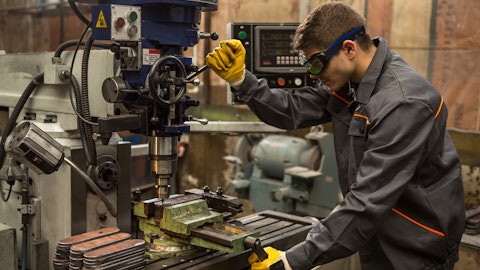Wabash National Corporation (NYSE:WNC) Q1 2024 Earnings Call Transcript April 24, 2024
Wabash National Corporation misses on earnings expectations. Reported EPS is $0.3928 EPS, expectations were $0.45. WNC isn’t one of the 30 most popular stocks among hedge funds at the end of the third quarter (see the details here).
Operator: Good day, and welcome to the Wabash National Corporation First Quarter 2024 Earnings Call. All lines have been placed on mute to prevent any background noise. After the speaker’s remarks, there will be question-and-answer session. [Operator Instructions] And finally, I would like to advise all participants that this call is being recorded. Thank you. I’d now like to welcome Ryan Reed, VP Corporate Development and Investor Relations to begin the conference. Ryan, over to you.
Ryan Reed: Thank you, and good afternoon, everyone. We appreciate you joining us on this call. With me today are Brent Yeagy, President and Chief Executive Officer; and Mike Pettit, Chief Financial Officer. Before we get started, please note that, this call is being recorded. I’d also like to point out that, our earnings release, the slide presentation supplementing today’s call, and any non-GAAP reconciliations are available at ir.onewabash.com. Please refer to slide 2 in our earnings deck for the company’s safe harbor disclosure addressing forward-looking statements. I’ll hand it off now to Brent.
Brent Yeagy: Thanks, Ryan. Good afternoon, everyone, and thanks for joining us today. Beginning with the first quarter of 2024, our revenue and income fell slightly short of our expectations, due to slower customer pickups of equipment. I’d like to emphasize that, particularly for a year of weaker demand Q1 tends to be seasonally weaker. Additionally, the size of our products, necessitates that we rely on customers to pick up their equipment before we were able to recognize revenue. That said, our production outstripped shipments during the first quarter to the delta versus our anticipated quarterly revenue and the associated income will flow into subsequent quarters during 2024 particularly Q2. As we’ll discuss later, our financial outlook for the year remains unchanged.
From a strategy perspective, we continue to enhance our network at 78 dealer locations. Through our marketplace joint venture we launched the initial version of our Wabash Marketplace in the first quarter. Collaborating with leading technology and logistics providers, the platform seeks to deliver customer-centric solutions through an integrated partner ecosystem that sets new industry standards for parts services and trailer capacity. The ultimate objective of the Wabash Marketplace is to develop a comprehensive end-to-end digital platform that transforms the experience for dealer’s customers and suppliers. Utilizing advanced technology and connectivity, we aim to streamline the supply chain experience, making it more efficient, connected, and user-friendly.
Dealers and customers will benefit from improved access to a wide range of parts and services with a particular focus on our Trailers as a Service or TAAS capabilities and the expansion of our Wabash Parts distribution network. The marketplace has significant potential for growth as the team focuses on opening up opportunities for additional value-added offerings. Also, our Wabash Parts distribution JV is reaching an initial stage of maturity that will facilitate meaningful growth in 2024. Of course, the synergy between our comprehensive First to Final Mile equipment portfolio, Wabash Parts and the Wabash Marketplace, and our Parts and Services segment, more broadly affirms our position in this market as we seek to add more value for our customers by supporting equipment through the course of its life cycle.
Confidently, investing in strategic growth initiatives during a down year in the trailer industry marks a new chapter for Wabash, one that we have not previously had the opportunity to explore. As we gain more clarity for 2024, it’s important to emphasize the resilience of our portfolio that has grown over the last decade. We see relative stability in customer demand for our truck bodies and tank trailers, which helps mitigate the anticipated decline in dry van demand this year. In addition to benefiting from strategic customer relationships with best-in-breed participants in trucking, logistics and retail, our expanded and diversified equipment portfolio not only enhances our stability through market cycles but also provides a stronger foundation for layering on strategic growth.
This backdrop positions us well to capitalize on market shifts and continue our innovation and leadership in the transportation, logistics and distribution industries. As we continue to advance our strategic objectives, a vital component is fostering higher levels of employee engagement, which we believe leads to enhanced execution and improved financial performance. At Wabash, we are dedicated to building a culture that embodies our core values and emphasizes respect for individuals. In line with this commitment, we have established a Culture Council, a multiyear initiative aimed at addressing critical aspects of our organizational environment. These include our work environment, working relationships while being in community, growth in autonomy, flexibility and consistency and systems and processes.
To bring these areas to life, we have formed cross-functional teams tasked with implementing changes that positively affect all employees and creating an environment where everyone can succeed. These teams represent various functions in geographical locations, ensuring a wide range of perspectives and ideas are being represented across the teams. This investment in our people and elevation of our internal standards not only aligned with our leadership responsibilities and values but also advance the interest of Wabash, our customers, partners, shareholders and our communities to the acceleration of our strategic vision and increasing sustainability of value creation. Moving on to market conditions. While our customers continue to experience a challenging freight environment, we have seen important leading indicators like the ISM index rising above 50, indicating expansion returning to the manufacturing sector, while surveys of inventory levels at shippers suggest abating headwinds from destocking that have been working against the freight market over the last couple of years.

While these positive indicators have yet to meaningfully translate into improved freight conditions, we are optimistic that improvements maybe on the horizon when you pair the strengthening macro backdrop with the amount of capacity that has left the transportation industry since the market downturn began in early 2022. Thinking beyond the current freight cycle, we remain bullish on our core markets benefiting from secular trends like power only, persistent driver shortages and the resurgence of nearshoring activity within North America. Shifting focus to our backlog. At the close of the first quarter, we had a total of $1.8 billion in orders with $1.5 billion of that figure expected to be shipped in the next 12 months. Both figures were lower by roughly $100 million sequentially, but it’s important to note that with over $500 million in revenue for the quarter, the relative stability of our backlog implies that we continue to see meaningful volumes of new orders.
Moving to our financial outlook. With the benefit of further visibility provided by our sizable backlog, we are reiterating our full year 2024 guidance of $2.3 billion of revenue and a midpoint of $2.25 of EPS. In closing, we are capitalizing on the opportunities presented by the market environment in 2024. With a diverse portfolio of First to Final Mile equipment and a growing Parts and Service business, Wabash is positioned with unprecedented strength paired with minimal leverage at this stage of the freight cycle. I believe our ability to maintain focused execution on our unique organic growth projects, underscores the strength of our strategic positioning for the future. We are actively working to deepen relationships with our dealers, suppliers and customers, as well as engaging with interesting new players within the transportation, logistics and distribution landscape.
Simultaneously, we are committed to fostering a culture of continuous improvement, within our own employee experience ensuring that we remain well equipped to act on our strategy. We are confident that this approach will not only enhance our financial performance at all points in the cycle, but also enable Wabash to sustainably grow our level of value creation for all stakeholders. With that, I’ll hand it over to Mike for his comments.
Mike Pettit : Thanks Brent. Beginning with a review of our quarterly financial results. In the first quarter our consolidated revenue was $515 million. During the quarter, we shipped approximately 8,500 new trailers and 3,690 truck bodies. As Brent mentioned, we saw some delays in customer pickups of equipment during the first quarter and we do anticipate the opportunity to recognize revenue on these finished goods in subsequent quarters, including second quarter. Gross margin was 14.8% of sales during the quarter, while operating margin came in at 5.7%. In the first quarter, we generated operating EBITDA of $46 million, or 8.8% of sales. Finally for the quarter, net income attributable to common stockholders was $18.2 million, or $0.39 per diluted share.
From a segment perspective, Transportation Solutions generated revenue of $470 million and operating income was $44 million. Parts and Services generated revenue of $49 million and operating income of $10.5 million. Year-to-date operating cash was an outflow of $17 million reflecting what is typically a back-ended quarter of shipments in Q1. Concerning our balance sheet, our liquidity which comprises both cash and available borrowings of $389 million as of March 31. We finished Q1 with net debt leverage ratio of 0.9 times. On capital allocation, during the first quarter we invested $19 million in capital projects utilized $16 million to repurchase shares and paid quarterly dividends of $4.2 million. Our capital allocation focus continues to prioritize capital expenditures above and beyond our annual maintenance CapEx spend of $20 million to $25 million in order to support our organic growth initiatives.
We are committed to maintaining our dividend and then we anticipate continuing to evaluate opportunities for share repurchase alongside of bolt-on M&A. Moving on to our outlook for 2024. We are reiterating guidance of a revenue range of $2.2 billion to $2.4 billion with a midpoint of $2.3 billion; and an EPS range of $2 to $2.50 per share with a midpoint of $2.25. We believe this outlook is well supported by a stable backlog and new order flow that continued at a reasonable pace during the first quarter. We continue to see truck body tank trailers and Parts and Services as stabilizing forces within our portfolio in 2024, as market conditions remain stronger in those businesses relative to dry van. In particular, we anticipate year-on-year growth in Parts and Services to accelerate as we move through 2024.
Thinking specifically about our second quarter, our expectation is for revenue to come in between $550 million and $600 million and for EPS to be between $0.50 and $0.55 per share. Moving on to capital deployment expectations for 2024. We anticipate traditional capital investments to be between $75 million and $85 million in 2024, as a result of planned expenditures to support our strategic growth initiatives. We also expect to invest in CapEx that will be immediately revenue generating through our Trailers as a Service program. We anticipate investment in that program will be back half loaded and we will give more specific guidance as the figure comes into focus, but we would expect at least 1,000 units in 2024. In conclusion, I’m excited about 2024 as we take the opportunity to demonstrate what we believe is an improved through-the-cycle financial profile for the company.
Additionally, Wabash currently enjoys the most significant potential for strategic growth in the company’s history, by pursuing our Parts and Service adjacencies and we’re eager to demonstrate our capacity to grow the top line of this business, to allow us to become a more meaningful contributor to our portfolio as a whole. As an industry leader in transportation equipment, positioned at the epicenter of an increasingly complex ecosystem of participants within the transportation, logistics and distribution industries, we have a unique opportunity to unite diverse stakeholders to address industry challenges via our Wabash Marketplace digital platform, as well as the Wabash Parts distribution business. And we look forward to updating you on the progress of this initiative.
We firmly believe that this area of strategic growth will define the next chapter in our journey to change how the world reaches you. I’ll now turn the call back to the operator, and we’ll open it up for questions.
See also 15 Best Affordable Dividend Stocks To Invest In Right Now and 21 Small Business Ideas for Kids.
Q&A Session
Follow Wabash National Corp (NYSE:WNC)
Follow Wabash National Corp (NYSE:WNC)
Operator: [Operator Instructions] And your first question comes from the line of Mike Shlisky of D.A. Davidson. Your line is open.
Q – Mike Shlisky: Yes. Hello. Thanks for taking my question.
Brent Yeagy: Good morning, Mike.
Q – Mike Shlisky: So I guess, I wanted to ask first about some of the pickup and logistical issues that might have changed things from the first quarter to the second quarter, or elsewhere during the year. I’m curious, was this an industry-wide phenomenon? Was it just an issue with Wabash and — having to get forced in [ph] andbeyond to get their trailers, and other people didn’t have an issue if they’re based elsewhere in the country. Just curious to see if, this is something that we should be thinking of as everyone is facing or is it just a strictly Wabash issue?
Brent Yeagy: Yes, Mike. I mean as we said in the release, and on the actual call, narrative we put out there. I mean, this is a normal type of situation that our industry feels across the board at any time that we are in, not only the first quarter of the year, but when compounded by being in a down year relative to dry vans, this is a normal and customary type of issue to have. So, everyone is feeling it throughout the overall industry, at this point. And in general, is to be expected in terms of weak pickups, as people are working to understand what needs to be put in service at this time of the year. So, while we were a little short in what those expectations are, the phenomenon itself, is a normal and customary industry fact
Q – Mike Shlisky: Okay. Okay. Thanks for that. I also want to ask about Trailer as a Service. Mike, you outlined a couple of details there. I understand that maybe you won’t get into actual numbers and guidance per se. I mean, you did mention at least 1,000 units. But just, how do we start to start to model that out? Do we model that as 1,000 units of sales, 1,000 units per inventory, with rental attached to it or leasing revenue attachment? I’m not sure, like what to put in my current model and what’s incurring guidance as far as that business is concerned.
Mike Pettit: Yes. So from a P&L perspective, Mike it will show up as a lease-type expense. You wouldn’t see a full unit of revenue recognition, like you would a ship. It will be a leasing-type model. So, you’ll see a monthly expense, you’ll see in monthly revenue and the associated expense From a cash flow perspective, you’ll see it show up in — we break it out in our statement of cash flows as a revenue-generating asset. And it will be separate from our normal plant property equipment. So, you can see as those units get put into service that will show up on that line in our cash flow statement.
Mike Shlisky: Okay. Maybe one last one for me. I guess some thoughts Brent about what you think has to improve in the market to see orders go up from current levels? I mean I guess we’ve had one large — or a few large bankruptcies happen over the last 12 months they had largely older units that probably didn’t get back in the market — in the used market sorry. I’m curious whether if there is capacity exiting the market today that might improve the high demand between [indiscernible] and loads whether some of those units exiting the market will be much newer and some of that used equipment may end up taking away from new over the next couple of quarters?
Brent Yeagy: Yes, Mike, I think what needs to happen is already happening. And I think the — what has always been evident within our industry is that when it is most confusing when there are mixed, kind of, at a level of most mixed signals is when the market is actually beginning to make the improvements that it needs to get it on the path of the upswing, right? So, we are seeing gross manufacturing activity begin to move a number of direction. We’re seeing capacity leave the market. We’re seeing imports continue to improve. The things that need to be happening are happening. Now, — and what they don’t have a real-time effect on freight and the spot market. That’s going to happen incrementally over the course of the next six months as it should from where we’re sitting right now.
So, everything still lines up for the I’ll say market forecasts that are out there by ACT and FTR there is really no deviation from the forces that drive that. And it’s exactly what should be happening to set up for the estimates for 2025. It’s already in play nothing new needs to happen. The I think from — one thing that gets questioned is what is the Fed going to do from an interest rate standpoint. The forces in play are already in play. It’s already factoring in where the Fed is at right now. So, if the Fed waits until let’s just say Q4 to have an interest rate reduction that is not going to probably materially affect the forces that will drive the upswing into 2025. So, I think the play is set that’s been called. It’s happening. It just needs to work itself out over time.
Mike Shlisky: Got it. I appreciate the color Brent. I’ll pass it along. Thank you.
Brent Yeagy: Thanks Mike.
Operator: Your next question comes from the line of Justin Long of Stephens. Your line is open.
Justin Long: Thanks and good morning.
Brent Yeagy: Good morning Justin.
Justin Long: So, I guess getting back to the delayed pickup of trailers, is there any way to quantify what that headwind was in the first quarter versus your expectation to just help us think through the catch up we could see in the second quarter? And then as you just take a step back and look at trailer shipments over the balance of the year is there any color you can provide on the quarterly cadence that is reflected in the guidance?




